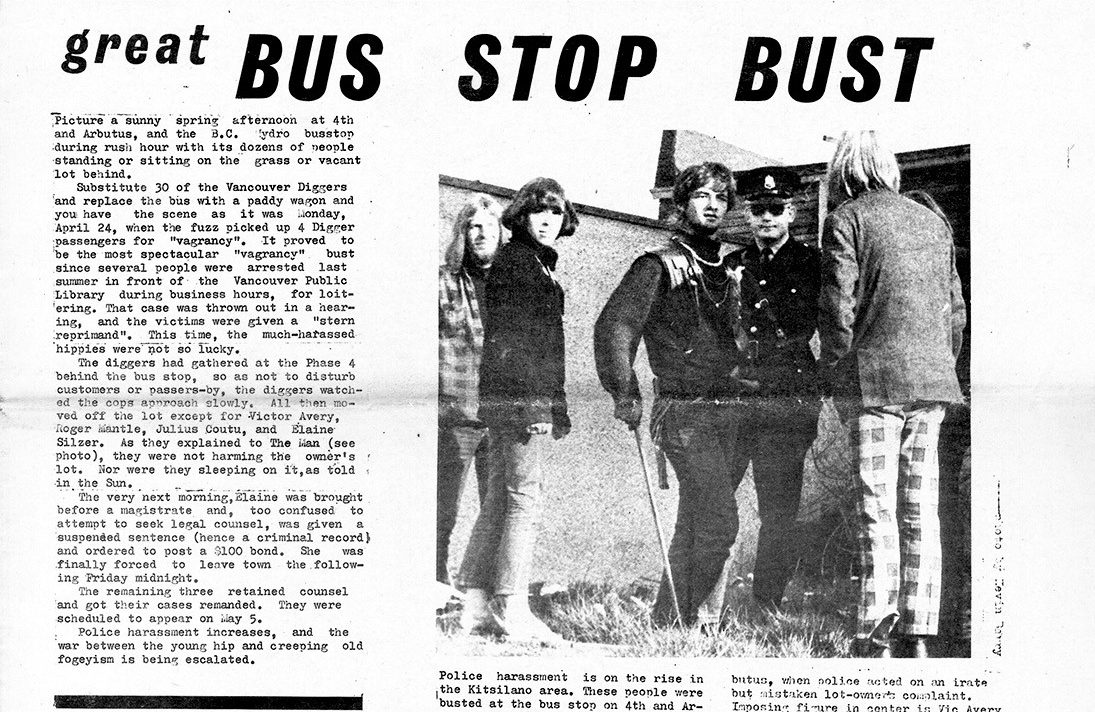Newspapers dubbed it the Gastown Riot, and some, like the Vancouver Sun and Province, blamed the organizers. Later, some would blame the Straight, which caustically disagreed with the charge. The cover of its next issue featured a full-page comic chronicling the melee while, inside, writers blamed plainclothes instigators and declared, “The Law Will be Made in the Streets.” The Straight, more bluntly, called it the Police Riot.
The Georgia Straight turns 50 this year. Its first issue was printed on May 5, 1967, at a dime apiece. It was hawked mostly by street vendors, as well as Dan McLeod, its publisher and editor. The city granted it a business licence, revoked it, and reinstated it again in its first year. By the end of its second year, the publication had been charged with 27 counts of obscenity, one charge of counseling to commit an indictable offence, and one count of criminal libel. (One charge of obscenity was dropped because the presiding Justice judged that the word “muffdiving” didn’t exist, and could therefore not be obscene.) Since its heady days as an alt-weekly flipping off institutional authority, the Straight has become an institution itself, accumulating numerous National and Western Magazine Awards, as well as a Vancouver Mayor’s Arts Award.
Writer Terry Glavin started writing for the Straight at age 18, in the early 1970s. After working at several lower mainland newspapers, he began writing for the Straight again in the 1990s. Nowhere else, he says, could the Straight have emerged. “There’s something that happens when you cross the Rockies … everything becomes psychedelic.” In the late 1960s, Vancouver became the epicentre of western Canada’s hippie counterculture, a Haight-Ashbury North. The Georgia Straight became its voice.
By 1979, following more than a decade of provocation, proto-environmentalism, and general civic antagonism, the Straight ceased to be. In an effort to shed its seedy reputation — and to survive — McLeod rebranded the newspaper as the Vancouver Free Press and dropped the scandalous personals. News and editorials, in particular, were verboten. In The Last Streetfighter, a 1997 documentary focusing on the Straight’s thirtieth year, McLeod explains his pivot. “I had a strict ban on news for many, many years, because I felt that’s what really got us in trouble — when we started giving opinions. That’s when the city would come down on us. As long as we stuck to entertainment, then we could build from that and eventually make the thing whole again.”
The Vancouver Free Press lasted a scant two years before re-emerging as the Straight again in 1981, but the focus remained on arts and entertainment. A year after that, McLeod made it a free, ad-supported weekly. Charles Campbell, who took over as editor in 1986, credits the shift for finally putting the Straight on firm financial footing and did what he could to keep it there. “I was very particular about developing coverage in an area until we owned it.” By the late 1980s, Campbell had helped lay the financial groundwork for the Straight’s next hallmark: aggressive investigative journalism.
The next decade, says Glavin, was the “glory days.” In 1994, the Straight published a lengthy investigation into the soon-to-be-scandalous PacifiCat ferries. The same year, it published a story about the presence of a potentially lethal parasite in Vancouver’s water supply. In 1995, itpublished Taras Grescoe’s “White Peril,” a provocative satire on white Vancouverites’ racist attitudes. The Straight had grown up. “It was serious journalism,” says Glavin. “Not hippie shit. It was a writer’s newspaper.”
The Straight still publishes serious journalism, too. In 2005, current editor Charlie Smith wrote an award-winning feature digging into Vancouver’s new convention centre. In 2008, the Straight featured Alex Roslin’s investigation into pharmaceutical sales, and in 2013, it printed his investigation into the appearance of irradiated fish in British Columbia stores.
“Institutions like the Straight are really important,” says Campbell. “I really hope — fervently hope — it survives the current upheaval in the media.” That upheaval, of course, is the implosion of ad-supported newspapers. “Shattered Mirror,” the Public Policy Forum’s 2017 report on the media, found that a sample of over 1,000 Canadian weeklies lost about a third of their revenue between 2012 and 2015 — a fate that’s caught up with them after escaping the beginning of print media’s decline in the aughts. The report also agrees with Campbell — weeklies play a critical role in civic life.
It’s a very conventional problem for the once-upon-a-time very unconventional Georgia Straight, which in the heady 1960s would’ve likely balked at being called an institution. But it grew up, and its youthful antagonism and politics gave way to respectability and responsibility. It changed, the city changed, and the industry has, too. Always, though, the Straight has adapted.
